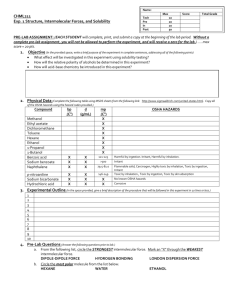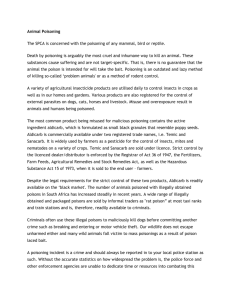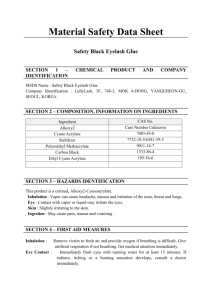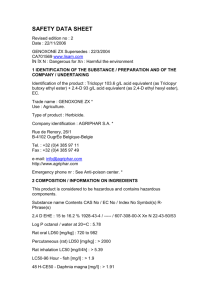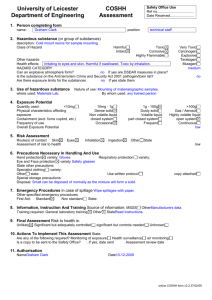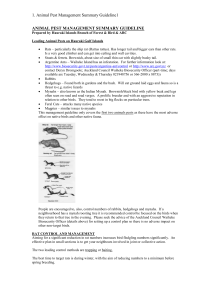SAFETY DATA SHEET - Scientific Supa-Kill
advertisement
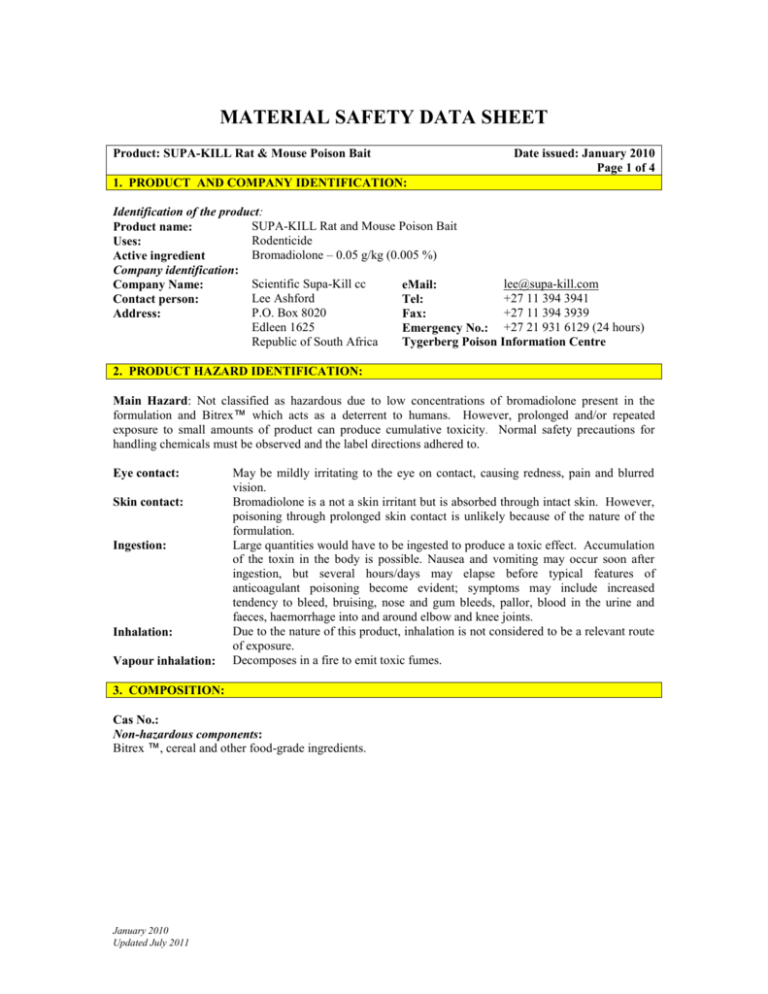
MATERIAL SAFETY DATA SHEET Product: SUPA-KILL Rat & Mouse Poison Bait Date issued: January 2010 Page 1 of 4 1. PRODUCT AND COMPANY IDENTIFICATION: Identification of the product: SUPA-KILL Rat and Mouse Poison Bait Product name: Rodenticide Uses: Bromadiolone – 0.05 g/kg (0.005 %) Active ingredient Company identification: Scientific Supa-Kill cc lee@supa-kill.com Company Name: eMail: Lee Ashford +27 11 394 3941 Contact person: Tel: P.O. Box 8020 +27 11 394 3939 Address: Fax: Edleen 1625 Emergency No.: +27 21 931 6129 (24 hours) Republic of South Africa Tygerberg Poison Information Centre 2. PRODUCT HAZARD IDENTIFICATION: Main Hazard: Not classified as hazardous due to low concentrations of bromadiolone present in the formulation and Bitrex™ which acts as a deterrent to humans. However, prolonged and/or repeated exposure to small amounts of product can produce cumulative toxicity. Normal safety precautions for handling chemicals must be observed and the label directions adhered to. Eye contact: Skin contact: Ingestion: Inhalation: Vapour inhalation: May be mildly irritating to the eye on contact, causing redness, pain and blurred vision. Bromadiolone is a not a skin irritant but is absorbed through intact skin. However, poisoning through prolonged skin contact is unlikely because of the nature of the formulation. Large quantities would have to be ingested to produce a toxic effect. Accumulation of the toxin in the body is possible. Nausea and vomiting may occur soon after ingestion, but several hours/days may elapse before typical features of anticoagulant poisoning become evident; symptoms may include increased tendency to bleed, bruising, nose and gum bleeds, pallor, blood in the urine and faeces, haemorrhage into and around elbow and knee joints. Due to the nature of this product, inhalation is not considered to be a relevant route of exposure. Decomposes in a fire to emit toxic fumes. 3. COMPOSITION: Cas No.: Non-hazardous components: Bitrex ™, cereal and other food-grade ingredients. January 2010 Updated July 2011 Product: SUPA-Kill Rat & Mouse Poison Bait Date issued: January 2010 Page 2 of 4 4. FIRST AID MEASURES: Eyes: Skin: Ingestion: Note to physician: Remove person/s from contaminated area and keep calm and reassured. Wash eyes with plenty of clean, cold water for at least 15 minutes. If symptoms persist, seek medical advice. Remove contaminated clothing. Rinse the affected skin area with plenty of water and soap. Do not rub skin hard. If bait is swallowed SEEK MEDICAL ATTENTION IMMEDIATELY. Do not induce vomiting. However, if medical assistance is not readily available and the ingestion of a large amount of bait was recent, (less than 3 h) induce vomiting by tickling the back of the throat, providing the person is conscious. Take to a doctor or hospital and show the MSDS or the product label. Bromadiolone is a delayed-action anticoagulant. Vitamin K1, administered by intravenous injection, is an antidote. Treat patient symptomatically and supportively. Stomach wash, followed by repeated doses of activated charcoal, may be effective if performed within 4 hours of ingestion. In the case of haemorrhages, prothrombin time should be determined and if elevated, Vitamin K 1 must be administered. If necessary, give small transfusions of matched, fresh blood or frozen fresh plasma to restore clotting factors. Continue treatment until prothrombin time normalises. CONTACT A POISON CENTRE FOR ADVICE. 5. FIRE FIGHTING MEASURES: Extinguishing media: Special hazards: Protective clothing: Further information: CO2 and dry powder for small fires and foam or water fog for larger fires. (DO NOT use a solid water stream as it may scatter and spread the fire). Decomposes in a fire to emit toxic fumes. Personnel involved in a fire situation with this material should wear self-contained breathing apparatus as toxic fumes may be given off. No unprotected person should be allowed in the vicinity. Do not allow run-off from fire fighting to enter drains or water courses. Cool closed containers exposed to fire with water spray. 6. ACCIDENTAL RELEASE MEASURES: Personal precautions: Small and large spills: Environmental precautions: Protective clothing to be worn when clearing spillage. Contain and sweep up dry spillage. Collect with a spade and deposit in a secure, properly labelled, closed container. In the case of spillage in water, use barrier devices to prevent dispersion of the product. Adsorb liquid spillage onto vermiculite and treat similarly. Dispose of waste in accordance with local/national regulations. Contact the competent authorities if the situation cannot be controlled. Prevent further leakage or spillage if safe to do so. Contaminated area should be washed down with cold water and a surfactant/detergent. Do not flush waste water into surface water or sanitary sewer system. 7. HANDLING AND STORAGE Suitable material: Handling/storage precautions: January 2010 Updated July 2011 Store in original, sealed container. Store under lock and key away from children, uninformed persons and animals. Store in a cool, dry place away from sources of heat and ignition. Store away from food, feed, eating utensils and drinking water. Product: SUPA-Kill Rat & Mouse Poison Bait Date issued: January 2010 Page 3 of 4 Handling and Storage cont. Clean protective clothing, used protective clothing and worker’s personal clothing, should be kept apart. At the end of each day, all protective clothing should be decontaminated, washed, rinsed and dried. Extra care must be taken when cleaning equipment after use. Wear rubber gloves and wash hands after handling. Avoid all contact by mouth. Contamination of food, feed, eating utensils and all sources of drinking water, rivers, dams, crops or grazing shall be prevented. Toxic to aquatic organisms, fish and wildlife. Bury all dead rodents and any bait not consumed at end of treatment. 8. EXPOSURE CONTROLS / PERSONAL PROTECTION Occupational exposure limits: Engineering control measures: Personal protection: None assigned. Introduce technical measures to lessen exposure. Keep dust to a minimum. Respiratory: When handling this material in an emergency, effective respiratory protection must be worn. Hands: Nitrile rubber gloves. Eyes: Close fitting safety goggles or face shield. Skin: Full length protective clothing and boots. 9. PHYSICAL AND CHEMICAL PROPERTIES: Appearance: Odour: Solubility in water: Flammability: Explosive properties: Other data: Wheat grains dyed red No significant odour. Insoluble Not flammable. None Combustible in case of fire. 10. STABILITY AND REACTIVITY Stability: Hazardous decomposition products: Situations to avoid: Stable under normal conditions. None expected to be formed under normal conditions. Hazardous gases may be produced in a fire. Prolonged contact with water may reduce the bait’s attractiveness to rats. 11. TOXICOLOGICAL INFORMATION Acute toxicity: (active ingredient) Acute toxicity: (formulation calculated) Carcinogenicity: Mutagenicity; teratogenicity and embryotoxic effects: January 2010 Updated July 2011 Rat acute oral LD50 1.125 mg/kg Rabbit dermal LD50 2.1 mg/kg Rat inhalation LC50 0 0.0043 mg/ℓ (4h) Rat acute oral LD50 22500 mg/kg Rabbit dermal LD50 42000 mg/kg Rat inhalation LC50 86.0 mg/ℓ (4h) (unlikely route of exposure). Not carcinogenic. Mutagenicity and teratogenicity studies have not shown any mutagenic, embryotoxic or teratogenic effects. Product: SUPA-Kill Rat & Mouse Poison Bait Date issued: January 2010 Page 4 of 4 12. ECOLOGICAL INFORMATION Aquatic toxicity: (formulation calculated) Bio-accumulation: Biodegradability: Mobility: Persistence in soil: Ground or surface water: Fish: LC50 (96h) mg/ℓ 28000 rainbow trout; 60000 bluegill sunfish Daphnia: Acute 48 hour EC50 40000 mg/ℓ Algae: Acute 72 hour EC50 growth 340.0 mg/ℓ Potential moderate. Slowly degraded in soil. Relatively immobile in soil. Aerobic degradation DT50 53 days, anaerobic degradation DT50 60 days. Unlikely to be a source of contamination. 13. DISPOSAL CONSIDERATIONS: Disposal methods: Disposal of packaging: Residue may be disposed of in accordance with local/national regulations. Empty containers to be disposed of in a responsible manner. Do not re-use for any other purpose. 14. TRANSPORT INFORMATION UN No. ADR/RID: IATA-DGR: 3027 Not classified as dangerous goods. Not classified as dangerous goods. 15. REGULATORY INFORMATION: Classification: Risk phrases: Safety phrases: National Legislation: T+: Very toxic; T: Toxic; N: Dangerous to the environment R27/28 Very toxic: By skin contact and if swallowed. R48/24/25 Toxic: Danger of serious damage to health by prolonged exposure or skin contact and if swallowed. R50/53 Very toxic to aquatic organisms; may cause long-term adverse effects in the aquatic environment. S 2 Keep out of the reach of children. S13 Keep away from food, drink and animal feed S20/21 When using do not eat, drink or smoke. Occupational Health and Safety Act No. 85 of 1993 (amended 2002). National Road Traffic Act No. 93 of 1996. Fertilizers, Farm Feeds, Agricultural Remedies and Stock Remedies Act No. 36 of 1947 as amended. Registration No. Republic of South Africa L5198. 16. OTHER INFORMATION: Exclusion of liability: The information provided in this Material Safety Data Sheet has been obtained from sources believed to be reliable. SCIENTIFIC SUPA-KILL c.c. provides no warranties, express or implied, and assumes no responsibility for the accuracy and completeness of the data contained herein. This information is offered for your consideration and investigation. The user is responsible to ensure that they have all the data relevant to their use. January 2010 Updated July 2011


